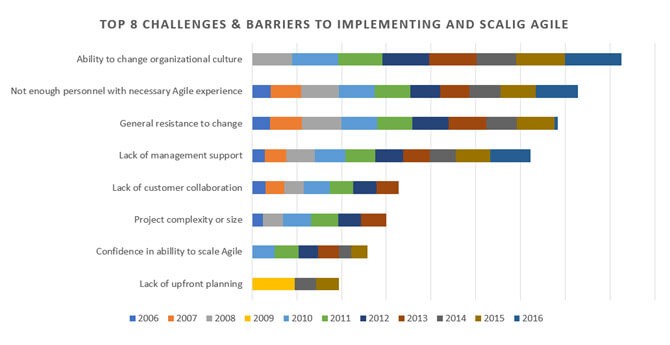To help answer this, we’ll present some of the top benefits and challenges of implementing agile and, most importantly, we will shed light on why your organization’s adoption of Agile is likely NOT a fad.
Just about everyone has heard of the term Agile, right? Whether you're a hard-core believer in the benefits of the Agile framework, a skeptic or agnostic, you've most likely heard of it or know someone who's using it. In software development, it’s hard to go anywhere without seeing signs of Agile adoption: teams holding stand-up meetings, teams working in Sprints, or clients, designers, developers and testers all working closely together.
Additionally, there are books, conferences, courses and coaches all devoted to Agile — it’s everywhere you turn. Some people even find it hard to imagine developing software any other way. Yet, over the last 50 years, many other approaches to delivering products and managing initiatives have made a big splash when initially introduced but have declined in popularity since then (e.g., CPM, PERT, RUP and PROMPTII, to name just a few) — just fads.
Why has the Agile approach withstood the test of time?
Let’s be honest, most people — and especially “Agileists” — really care about one thing: quickly delivering quality software by identifying the most optimal path from ideation to working software. In its purest form, Agile creates a situation where the team can move quickly and easily.
This framework helps guide teams in the right direction without prescribing every step. It empowers teams and makes work fun. Cristina, a director of Agile transformation at a large restaurant hospitality firm, says, “Agile teams feel more empowered about making decisions and proud about what they are able to deliver.”
The teams delivering the solutions have a significant impact on how to deliver, and this may be the strongest driving force behind the Agile approach. Agile makes the ideas of autonomy, mastery and purpose part of the delivery team’s shared paradigm. For this reason, teams are often able to maintain consistent momentum and a sense of accomplishment.
VersionOne, a leading project management software provider, has conducted an annual survey for the past 12 years titled annual “State of Agile Survey.” The survey has polled thousands of professionals in different industries to “take the pulse” of the current state of Agile adoption, implementation and success.
According to the survey, Agile is maintaining a stronghold as one of the most effective ways to accelerate the delivery of business value. Let's explore the top benefits behind Agile’s popularity, according to a summary of the survey results from 2006 to 2016:
- Helps manage changing priorities
- Increases productivity
- Elevates team morale
- Improves quality
- Accelerates time to market







